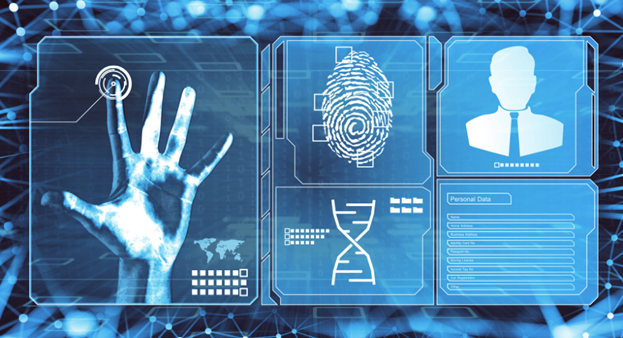Biometrics at Work:
Smarter Security or a Step Too Far?

Fingerprint scanners. Facial recognition. Voice ID. These aren’t just features on smartphones anymore—they’re showing up in offices, warehouses, and even small retail shops. As biometric technology becomes more accessible, many small businesses are starting to ask: Is it worth using for security or employee management?
Like most tech, biometrics offers clear benefits—but it also comes with real concerns. Here’s what small business owners and managers need to know before jumping in.
What Are Biometrics, Exactly?
Biometrics refers to the use of a person’s unique physical or behavioral traits—like fingerprints, facial structure, voice, or iris patterns—for identification. You’ve probably used them to unlock your phone or authorize a payment.
In a business setting, biometrics might be used for:
- Employee time clocks
- Physical building access
- Secure logins to systems or software
- Customer identification or payment
✅ The Pros: Why Biometrics Are Appealing
1. Stronger Security
Unlike passwords or keycards, biometric data is tied to the individual. It’s difficult to fake a fingerprint or spoof a face scan, making it harder for unauthorized users to gain access. For businesses dealing with sensitive data—or just looking to protect their space—this can be a big plus.
2. No More Forgotten Passwords or Lost Badges
Biometrics remove the need for employees to remember logins or carry access cards. That means fewer calls to IT for resets, and less downtime due to forgotten credentials.
3. Faster Access
Whether it’s clocking in for a shift or unlocking a secure file, biometrics make the process fast and frictionless. For businesses where time is money, even small efficiencies can add up.
4. Better Time Tracking
Some small businesses use biometric time clocks to prevent “buddy punching” (when one employee clocks in for another). Biometric systems ensure that the person clocking in is the person actually working.
⚠️ The Cons: Risks and Concerns to Consider
1. Privacy Concerns
Biometric data is deeply personal. Unlike a password, you can’t reset your fingerprint if it’s stolen. Employees may have concerns about how their data is being stored and used—and in some states, privacy laws require explicit consent and specific disclosures.
Failing to address these concerns up front can erode trust or even lead to legal issues.
2. Security Isn’t Foolproof
While harder to steal than a password, biometric systems are not invincible. If a database storing fingerprints or facial scans is breached, that data can be sold or misused—and it can’t be changed. That makes secure storage and encryption absolutely critical.
What Can Hackers Do with Stolen Biometric Data?
Unlike passwords, you can’t change your fingerprints or face. That makes stolen biometric data a goldmine for cybercriminals. Hackers may use it to bypass biometric authentication systems (especially those without additional safeguards), sell the data on the dark web, or combine it with other stolen information to create fake identities. In some cases, biometric data can also be used in social engineering attacks—where an attacker mimics your identity to gain access to systems or facilities. Once exposed, that data can follow a person or business indefinitely, increasing long-term risk.
3. Compliance and Legal Risks
Some states (like Illinois, Texas, and Washington) have laws governing how biometric data is collected, stored, and shared. Failing to comply could result in hefty fines. Even in states without specific laws, general data protection rules still apply.
If you’re thinking of adding biometrics, make sure you understand the legal landscape—or work with an IT provider who does.
4. System Failures or Errors
No system is perfect. A smudge on a fingerprint scanner, a poorly lit room for facial recognition, or a bug in the software can all cause failed attempts. If biometrics are your only method of access, you need a solid backup plan.
So… Should Your Business Use Biometrics?
It depends. For some small businesses—especially those that need strict security or accurate employee tracking—biometrics can be a smart upgrade. But it’s not plug-and-play. If you’re considering biometric tools, here are a few tips to move forward wisely:

✔️ Best Practices for Using Biometrics Safely
- Get Clear Consent
Always inform employees or customers if you’re collecting biometric data, why you’re doing it, and how it will be used. Have them sign a written consent form. - Don’t Rely on Biometrics Alone
Use biometrics as one layer in a broader security plan.
Combine it with secure passwords, multifactor authentication and good access control.
Want to know why we always recommend pairing biometrics with MFA? Learn more here. - Encrypt and Protect Data
Store biometric data securely. Use strong encryption and limit who has access to it. - Have a Fallback Option
Whether it’s a PIN, badge, or backup login method—don’t leave anyone locked out if the biometric system fails. - Stay Up to Date on Laws
Check your state’s privacy laws regarding biometrics, and review your practices regularly to stay compliant.
Final Thoughts
Biometrics offer a glimpse into the future of business security—but they also raise serious questions about privacy and responsibility. Used thoughtfully, they can be a valuable tool. Used carelessly, they can create risk and mistrust.
At the end of the day, it’s not about chasing the newest tech—it’s about using the right tools for your business, in the right way.
If you’re wondering whether biometrics are a good fit for your business—or how to keep your systems secure—we’re happy to talk it through.

